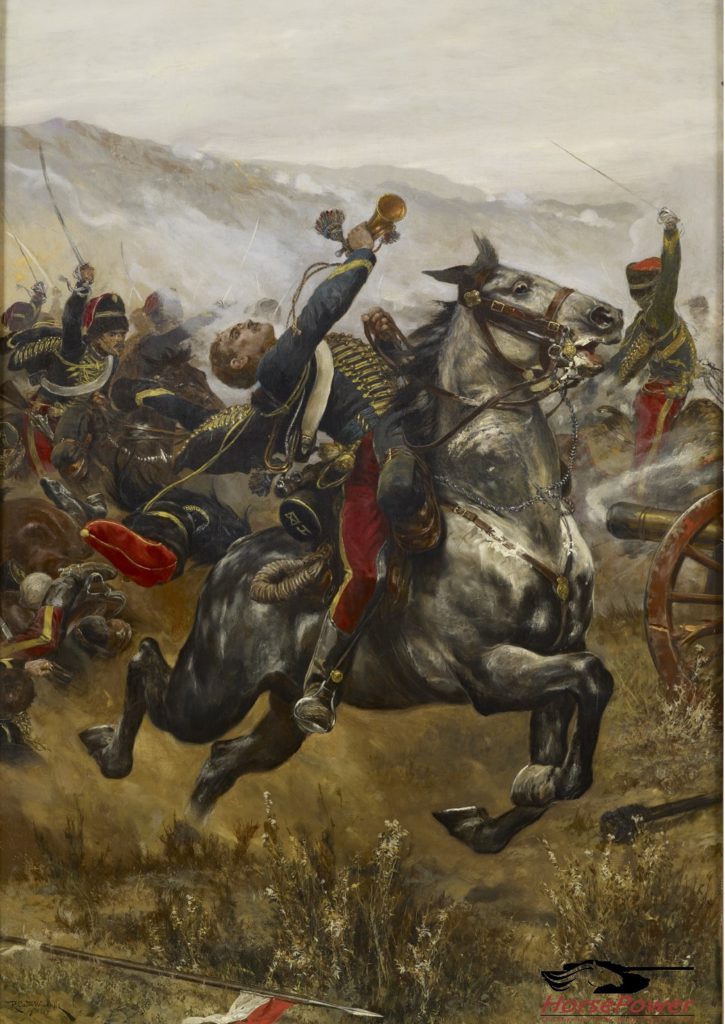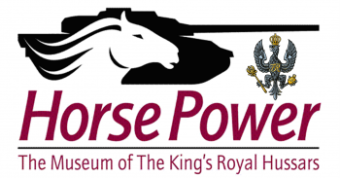The 11th Hussars in the Charge of the Light Brigade
25th October 1854 saw one of the most famous military blunders in history – the Charge of the Light Brigade. This action was part of the Battle of Balaclava, in the ill-fated Crimean War between Great Britain, France, Turkey and their allies against Russia. For the British and French, the most serious fighting took place in the Crimean Peninsula (recently in the international spotlight again), when they besieged the important sea port of Sevastopol.
Balaclava is a small port some distance from Sevastopol, where the British had established their main supply base: in the early hours of the 25th October, the Russians launched a major attack to try and capture the town.
The initial attack was successful, with a line of strongpoints (“redoubts”) along a crest of high ground being captured. However, a cavalry attack on a regiment of British infantry (the 93rd Highlanders) defending the port of Balaclava was repulsed by the “thin red line tipped with steel”, and a subsequent attack on five British cavalry regiments of Dragoons and Dragoon Guards (The Heavy Brigade) ended with the Russian cavalry being chased from the field.

This left five regiments of Hussars, Light Dragoons and Lancers (The Light Brigade) which had not been involved. The British commander, Lord Raglan, sent a series of confusing orders to his subordinates (Lord Lucan commanding all the British cavalry and Lord Cardigan commanding the Light Brigade). These orders, combined with impatience, stupidity and personal animosity between Lucan and Cardigan (who were brothers in law!) led the Light Brigade mistakenly to charge Russian guns at the end of a valley nearly one and a half miles distant.
It was madness: the Russians occupied the heights on both sides of the valley, with artillery and riflemen; at the end of the valley was the main Russian artillery position, protected by more infantry and cavalry. The Light Brigade was, in the words of the poet Tennyson, 600 strong. In actual fact, the strength was closer to 670.
The 11th Prince Albert’s Own Hussars were in the second line of the Light Brigade (the 13th Light Dragoons and 17th Lancers were in front, with the 4th Light Dragoons and 8th Hussars behind them). The 11th was commanded by Lieutenant Colonel John Douglas, who had first joined the army in 1829, transferring to the 11th Hussars in 1839. With him were 5 officers, a medical officer, Regimental Sergeant Major Bull and 135 men.
The best account of what happened to the 11th comes from the pen of Troop Sergeant Major Loy Smith, whose diary is in our museum’s possession. “As we moved off the Russians opened fire from all their batteries, the round shot passed through us, and the shells burst over and amongst us, causing great havoc. The first man of my Troop that was struck was Private Young, a cannon ball taking off his right arm, I being close in his right rear, fancied I felt the wind from it as it passed me, I afterwards found I was bespattered with his flesh.”
As the charge progressed, “Many riderless horses were now galloping along with us, forcing their way up into the ranks, and keeping their places as though their masters had been on their backs.” Smith lost some of the lace on his cuff to a bullet, but made the Russian gun line in one piece. The 11th then passed through the Russian lines for another 100 yards (no other regiment got so far), where they saw the waiting Russian cavalry. Smith says: “Colonel Douglas, seeing that there was no time to lose … called out ‘Give them another charge, men, Hurrah’ … Waving our swords over our heads, on we galloped …”
Smith estimates that there were about 80 of the 11th left by this stage. He and three men attacked a Russian gun, but were themselves attacked by Cossacks (Russian light cavalry). At this point a stand-off ensued, with the surviving British cavalrymen faced by a large Russian force. While the two sides stood face to face, more cavalry came behind the British. Douglas thought they were the 17th lancers, but one of his officer shouted out that they were Russians. “Colonel Douglas shouted, ‘Then fight for your lives’ Every man was now left to himself to take his own course …”

The few men left started to return to whence they came. Smith rode through a group of Russian lancers and then his horse was wounded. Her leg was broken, so Smith quickly jumped down and started to run, carrying his sword: he was about a mile from safety. He passed a square of Russian infantry “The ordeal was something frightful, for I expected every moment to be struck.” He was then chased by some Russian lancers, who left him and killed two of his comrades.
During his journey he had several close shaves and strange encounters. Strangest was with two wounded Russians who were from the 11th Russian Hussars. Smith cut a button from the coat of one of them “The next day I cut a button off my own jacket and sewed it on in its place, where it still remains.”
While with the wounded men, Smith managed to catch a riderless horse of the 4th light Dragoons and mounted it, safely reaching the British lines. As he returned, the 11th Hussars were ‘numbering off’ (i.e., counting the number of men present) “…I called out 63, as 62 was the last number I heard … I was the last man that returned up the valley.”
That night “ … the order was ‘No fires to be lit, no noise to be made;’ and this was indeed a sorry night, scarcely any had had more than a little biscuit and a dram of rum since the day before, it was spent by us standing in groups talking over the sad misadventures of the day.”
An officer of the 11th Hussars, Lieutenant Alexander Roberts Dunn, was awarded the Victoria Cross – the only VC ever won by an 11th Hussar. One officer was killed and two wounded in the Charge, and 25 other ranks also died. 24 men were wounded and 7 taken prisoner.
Colonel Douglas died in bed in May 1871, commanding the Cavalry Brigade at Aldershot. Private Richard Albert Young survived his wound and lived until at least 1890. Lieutenant Dunn, VC, died (by then a Colonel) in Abyssinia (now Ethiopia) as a result of an accident while commanding an infantry regiment. Sergeant Major George Loy Smith was awarded the Distinguished Conduct Medal; he left the 11th (which he had joined in 1833) in 1859 and became a Yeoman of the Guard. He died in hospital in 1888 and the age of 71.
The last surviving man of the 11th Hussars to die was William Pennington (who became a Shakespearean actor), who died in May 1923, while the last survivor, Edwin Hughes of the 13th Light Dragoons, lived until May 1927 – over 70 years after the Charge.
HorsePower Museum has many items relating to the Charge of the Light Brigade, including a hoof from Ronald, the horse which Lord Cardigan rode at the battle.


